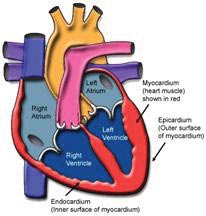COXSACKIE B VIRUS FACT SHEET
What is Coxsackie B Virus?
The Coxsackie virus was first isolated in Coxsackie, New York in 1948. There are six
different Coxsackie B viruses, each responsible for different symptoms and diseases.
Coxsackie B viruses are responsible for numerous cases of central nervous system
infections in infants and children, as well as heart muscle infections in both children
and adults. These viruses are the most common agent for myocarditis (inflammation
of the muscular walls of the heart) and dilated cardiomyopathy (a group of disorders
where the heart muscle is weakened and cannot pump effectively resulting in the
dilation of the cardiac chambers).
What are the Symptoms and the Incubation Time?
Human Coxsackie B virus infections are common and frequently asymptomatic (without symptoms). The diseases can cause symptoms ranging from mild gastrointestinal upsets (illness relating to the stomach or intestines) to paralysis, heart damage and birth defects, although the subclinical and mild infections are the most common. Infection with the Coxsackie B virus is characterized by: fever, fatigue, malaise (body discomfort) and chest pains. The incubation time for most coxsackie viruses is 2-10 days and the onset of cardiac symptoms usually occurs about two weeks after viral infection.
Coxsackie B is responsible for the onset of many diseases, some of which include: the common cold, pleurodynia (sudden attacks of pain of soreness of the muscles between the ribs), aseptic meningitis (inflammation of the membranes surrounding the brain and spinal cord), upper respiratory tract (nasopharynx, oral cavity and throat) infection, myocarditis and pericarditis (inflammation of the membranous sac that surrounds and protects the heart). Coxsackie B viruses have also been known to cause: encephalitis (inflammation of the brain), flaccid motor paralysis (paralysis with loss of muscle tone), exanthema (appearance of lesions on the skin), rash, pneumonia (inflammation of the lungs) and generalized disease of the newborn.
How Long do the Symptoms Last?
The duration of the Coxsackie virus varies and is dependant on the specific type of infection. For Coxsackie fever without any other symptoms, body temperature usually returns to normal within three to five days. In pleurodynia, fever and muscle pain will usually last for one to two days.
How is it Diagnosed?
Doctors diagnose a Coxsackie virus by performing an exam and checking for the characteristic symptoms of the disease. Feces and the fluids from the back of the throat may also be tested to determine if the virus is present.
Am I at Severe Risk for Disease?
Infection of the heart by the Coxsackie B virus can lead to viral myocarditis – an inflammatory disease of the heart that can cause heart failure. The disease does not usually cause death, but permanent heart damage can occur. There are usually no long-term complications from the mild illnesses/symptoms caused by the Coxsackie B virus. However, some patients who have paralysis may not fully recover. Those who develop dilated cardiomyopathy (heart failure) from myocarditis will require long term care for their symptoms.
How Does Coxsackie Spread?
The Coxsackie B virus gains access to the body through the mouth by the fecal-oral mode of transmission. The virus may also spread through contact with infected mucosal secretions. Someone may become infected by direct contact with the secretions from an infected person, or by contact with contaminated surfaces or objects, such as a drinking glass, or a telephone.
How Can I Prevent Getting Coxsackie?
The Coxsackie virus cannot be prevented, but it can be controlled through sanitary measures. General cleanliness, frequent hand washing and the avoidance of contaminated water are the best defences.
How do I Prevent Spreading it to Others?
Children who are sick with the Coxsackie virus should be kept out of school or day care for a few days to avoid the spreading of infection. If infected with the virus, take extra care to thoroughly wash your hands after using the bathroom and especially before preparing food for others.
What is the Treatment for Coxsackie?
There is not currently a vaccine to prevent Coxsackie B virus infection; however, depending on the type of infection and the symptoms, certain medications may lessen the severity of the symptoms.
How Prevalent is Coxsackie in Surface Water/Well Water?
Not much is known about the presence of viruses in water, but it is known that fecally contaminated water is an important factor. The groundwater from which well water is obtained can be fecally contaminated from failed septic systems or sewage lagoons and leaking sewer lines. The contaminated substances can reach the groundwater through soils and cracks in the ground. Other factors that contribute to the contamination of drinking water occur at or near water-supply wells. The main causes are poor well location and/or construction and the presence of test-holes or exploratory wells. Inadequately disinfected distribution systems, including storage towers, can also be a major source of microbial water contamination.
How Can We Protect our Water Supplies?
Protecting the groundwater source is an important part in making certain that the wellhead areas of all public water systems are free from contaminants. Source protection includes following well construction codes and implementing wellhead protection programs. Disinfection is also a very important step in reducing waterborne illness, and is implemented to remove, inactivate or kill disease-causing microorganisms. Disinfection treatments include chlorination, ozonation, reverse osmosis, ultraviolet light and nanofiltration (filtering the water through filters with a very small pore size).
Did you know that our Operation Water Health program provides teachers with the information they need to teach their students about what safe drinking water is, what unsafe drinking water is, and the health problems that can be caused by unsafe drinking water? Please help us to keep our Operation Water Health program updated! Please chip in $5 or donate $20 or more and receive an Official Donation Receipt for Income Tax Purposes.



